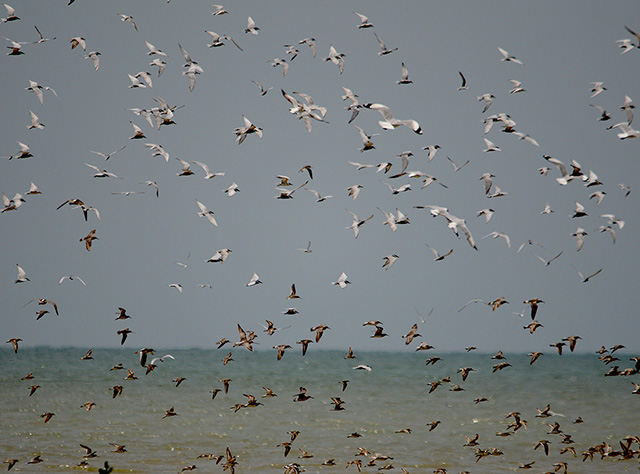There
was only one reason I found myself at the swamp forest of Air Hitam Dalam in
mainland Penang for the second consecutive time and it was to attempt for the
rare migratory Slaty-legged Crake again. In fact, it could well be my final try
as spring migration will draw to a close soon. This species would be a
significant addition to my life list and naturally, anxiety was high despite my
calm appearance. After all birding is about luck and lady luck has been unkind
to me so far.
As
I patiently waited for the distinguished visitor to reveal itself, I tried my
best not to be distracted by other species present in the vicinity. But a
little brown job flitting about the foliage of the forest could not be taken
lightly especially at this time of the year. During passage, one has no idea
what might decide to make a stopover at one of the few remaining forests in
mainland Penang. Upon further scrutiny, it turned out to be an Asian Brown Flycatcher.
It may be a common migrant to this part of the world but a confiding individual
like this deserves some attention.
The
resident pair of Mangrove Blue Flycatchers serenaded the locality with their pleasant
territorial calls. The striking colouration possessed by these birds also helped
to pass the time during my tedious wait for the Slaty-legged Crake.
There
is not much aesthetic appeal to be found on the Abbott’s Babbler but an adult
bird with a recently fledged juvenile in tow indicated yet another successful
breeding season for this robust undergrowth dweller.
A
Blue-winged Pitta in full view would have normally made my day because pittas
are such amazing creatures. However, I was a man on a mission today and the
stunning beauty of the Blue-winged Pitta did not have the usual influence over
my emotions.
I
sighed in relief when the Slaty-legged Crake finally strolled into view. It was
a young bird as it lacks the colour intensity of the adult birds. Not that it
mattered. I was transfixed on the rhythmic gait of the crake. The exhilaration
was intense and I struggled to keep my hands steady as I accumulated digital
memories of the encounter.
Almost
as soon as it appeared, the rare migrant disappeared back into the swampy
undergrowth and the performance was over. I managed to obtain the images I
wanted but most importantly, acquired a lifer which is a rare thing for me
nowadays.
My
companion and I decided the explore the surrounding areas but by then, the
temperature had started to soar. A lone Dollarbird seemed unperturbed by the
scorching heat and took no effort to seek some shade. Inevitably, the harsh
lighting made photography of this attractive bird difficult.
April
is the best time to catch the Pond-Herons in their breeding plumages before
they undergo the journey back north to breed. We recorded all three species on
this trip but unfortunately, none were confiding enough for any memorable
photographs. This mediocre image of an Indian Pond-Heron foraging in a sea of paddy
stalks still managed to wriggle its way into this blog post. Being the rarest
of them all has got absolutely nothing whatsoever to do with it.
The
scrubland habitat was ideal for Red-wattled Lapwings and we found several
individuals in the vicinity. The absence of any other notable species cut short
our exploration here and we turned our attention to the coast.
The
timing of our arrival at Kota Kuala Muda was ideal with the rising tide pushing
the waders and other water fowl to the high tide roost. However, it was a case
of so close and yet so far. There was no safe walking access to the roost and inevitably,
we made our way as far as the sandy beach was willing to take us.
We
had some consolation in the form of Common Terns. A few of these graceful
coastal terns decided to roost on the beach and they provided the best photographic
opportunities here.
One
of them has a deformed lower mandible but judging from its overall appearance, life
goes on as normal for this determined individual.
Some
waders were also found roosting close to shore but the heat wave was too
overwhelming for any decent photographs. Nevertheless, the sight and sounds of thousands
of roosting water birds is always a breath-taking affair. As Hor Kee did a
final sweep of the roosting flocks for any surprises with his scope, I took the
time to enjoy the spectacle before we wrapped things up for the day.


















